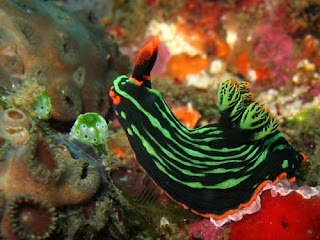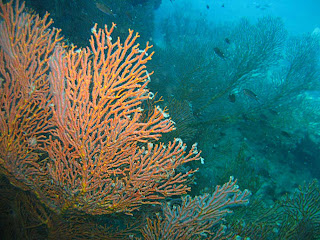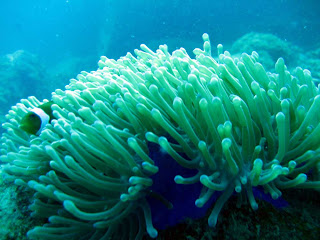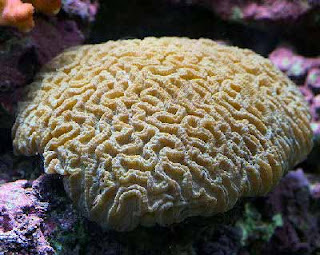Diver ! ! !
Tuesday, April 17, 2012
What is Nitrox?
Nitrox refers to gas mixture composed of nitrogen and oxygen; which is approximately 78%nitrogen, 21% oxygen, and 1% other gases, primarily argon. The most common use of nitrox mixtures containing higher than normal levels of oxygen is in scuba, where the reduced percentage of nitrogen is advantageous in reducing nitrogen uptake in the body's tissues and so extending the possible dive time, and/or reducing the risk of decompression sickness.
About Nitrox can be listed as follow:
a) Nitrox is technically any mixture of nitrogen and oxygen, but more commonly considered to be
an oxygen-enriched mixture.
b) Oxygen-enriched air has been actively used for more than 30 years, and has existed as a concept
for more than 200 years.
c) Manipulating oxygen levels was essential to certain military operations, and became common in
commercial, scientific, and medical fields as early as World War II.
d) The National Oceanic and Atmospheric Association (NOAA) released the first publicly available
Nitrox tables in 1979, fueling the use of Nitrox in the recreational communities.
e) Nitrox gained significant recreational popularity in the early 1990’s.
f) Bottom time and/or decompression obligation is related to the accumulation of metabolically inert gasses (such as nitrogen). Since Nitrox reduces the percentages of metabolically inert gasses
in the diver’s breathing mixture, it can significantly impact bottom time and/or decompression.
g) Less nitrogen in the diver’s breathing mix allows for longer bottom times and safer dives. For
example, a 60ft (18m) Nitrox dive can last for 100 minutes as compared to 60 minutes on air.
Custom Nitrox mixtures allow divers to maximize their bottom time while reducing the risk of
decompression sickness.
Table : NO DECOMPRESSION LIMITS WITH AIR AND NITROX
Sunday, April 15, 2012
Technical Diving
Technical diving (or Tec diving) is a form of scuba diving that exceeds the scope (in terms of depth, bottom time and type of diving) of recreational diving and not for military application. Technical divers require advanced training, extensive experience, specialized equipment and breathing gases.
The following
table gives an overview of the differences between technical and recreational
diving.
Activity
|
Recreational Diving
|
Technical Diving
|
Deep diving
|
Maximum depth of 40 meters
(130 ft)
|
Beyond 40 meters (130 ft)
|
Decompression
diving
|
No decompression
|
Decompression diving
|
Mixed gas
diving
|
Air and Nitrox
|
Trimix, Heliox, Heliair and Hydrox
|
Gas switching
|
Single gas used
|
May switch between gases to
accelerate decompression and/or "travel mixes" to permit descent
carrying hypoxic gas
mixes
|
Wreck
diving
|
Penetration limited to "light
zone" or 30 meters (100 ft) depth/penetration
|
Deeper penetration
|
Cave diving
|
Penetration limited to "light
zone" or 30 meters (100 ft) depth/penetration
|
Deeper penetration
|
Ice diving
|
||
Rebreathers
|
Some agencies regard use of
semi-closed rebreathers as recreational diving; others as technical diving.
|
|
Solo diving
|
Recreational diving requires buddy
system
|
Solo diving
|
Saturday, April 14, 2012
Support Marine Conservation
Here are some useful resources of Marine Conservation:
Your support are very appreciated.
Project AWARE Foundation
Teaching the world about the importance and responsibility of preserving the aquatic environment and it's resources.
Marine Conservation Society - MCS.org
MCS' vision is for seas rich in wildlife, abundant fish stocks and pollution free beaches and bathing waters – seas that are fit for wildlife to thrive in and for people to enjoy, and seas that will support future generations with abundant resources.
SeaWeb - SeaWeb.org
A multimedia public education project designed to raise awareness of the world ocean and the life within it.
The Global Coral Reef Alliance GCRA
Global Coral Reef Alliance, GCRA, a non-profit, is dedicated to protecting, growing, restoring, studying and managing coral reefs around the world.
Reef Check
Founded in 1996, Reef Check is a volunteer, ocean conservation organization designed to save coral reefs globally and temperate reefs in California. Reef Check is active in over 82 countries and territories throughout the world.
Blue Ventures
Blue Ventures is an award winning not-for-profit organisation dedicated to facilitating projects and expeditions that enhance global marine conservation and research
Dolphin Care
We aim to achieve better conservation of dolphins in the seas around Britain by involving the public in the monitoring of populations and the threats they face, hundreds of dolphins are dying every year due to By-Catch
The Shark Trust
The Shark Trust promotes the study, management and conservation of sharks, skates and rays.
Ocean Trust
Ocean Trust is a member supported, ocean conservation foundation building science, conservation and seafood partnerships to sustain the oceans as a food source for humanity.
Sunday, September 18, 2011
Nudibranchs
Scuba Diving is not just recreactional activity to meet people, do things, go place but help us understanding of the aquatic wonderful underwater world. Accordingly National Geographic there are more than 3000 known nudibranch species, and scientists estimate there are another 3000 yet to be discovered. We as a certified diver we may discover a new species on our driving trip. Probably the most fascinating thing about the nudibranch is the impressive amazing colors. The nudibranchs have the unique shapes, wonderful colors and amazing patterns of mircolife on earth.
Nudibranch is the marine gastropods that constitute the order Nudibranchia (subclass Opisthobranch of the class Gastropoda). Nudibranchs are often casually called "sea slug", but many sea slugs belong to several taxonomic groups which are not related to nudibranchs.Nudibranchs possess a radula feeding organ, but they characteristically lack of shell, gills, and mantle cavity typical of other mollusks.
The delicately colored body has bizarre outgrowths, called cerata, which serve a defensive function, discharging nematocysts that the nudibranch has ingested from cnidarian prey. Cerata also function in gas exchange Antenna-like organs (rhinophores) arise from animal's head.
Nembrotha kubaryana - By Erwin Kodiat
Body black, pustules green and connected into longitudinal lines in some forms; rhinophores and edge of foot bright with orange or red;gills with orange, red or green.
Chromodoris annae - By Sam Ong Beng Hui
Powder-blue, finely speckled with dark spots, and a black band as border, usually with short gap(s) at front and a short black line betwwen rhinophores; edge of mantle white with yellow submarginal band, white gap between black and yellow band distinct and even; gills and rhinophores yellow to orange.
Roboastra gracilis - By Dave Morgan
Body black with yellow to orange lines or instead of lines, numerous dashes forming lines, white to bluish, long gills and rhinophores.
Phyllidia coelestis - By Steven Tessy
Bluish grey with three broad black stripes; tubercles from mostly grey when small to many with yellow tops when large; rhinophroes yellow.
Pteraeolidia ianthina - Dave Harasti
Very long and slender with cerata in fan-like clusters, colour from white (juvenile) to brown, orange and iridescent blue, depending on food source and accumulated zooxanthellae.
Jorunna funebris - By Ronnie Ng
White with irregular dark blotches, usually circular, formes by black tubercles group together, foot with black spot along its margin, rhinophores with tops and gills with black on branches.
Chromodoris coi - By Erwin Kodiat
Mantle large, covering most of its foot;creamish white to pale-pinkish brown with distinctive wavy black-line on upper encircling gills and rhinophores, the inside area slight darker and line offset by white on the outside; gills and rhinophores similar in colour to inside area of upper part.
Discodoris boholiensis - By Mulyadi Setiono
Translucent yellowish white with numerous small brown or white spots and brown blotching, varying to black blotches and white lines around edge of mantle; gills and rhinophores mostly dark brown.
Hypselodoris purpureomaculosa - By Color Chen
White with dark-brown to black blotches, mantle with broad orange to orange-red edge; gills and rhinophores coloured like the mantle edge.
Hypselodoris bullockii - By Sam Ong Beng Hui
Creamy white to deep pink and a thin, distinct white margin on mantle; gills and rhinophores pale yellow to orange.
Asteronotus cespitosus - By Peter Vermeul
Variable from brown to yellow, usually with large broad, lump-like tubercles, often a row or continuous rise over midline of dorsum; gills large, usually reddish; rhinophores as body colour; mantle margin thin and often broadly yellow.
Chelidonura amoena - By Indra Swari
Headshield slug with rounded head, 2 long tail like appendages. Colour is grey-brown, fading at sides, with a fine white punctuation and yellow tips.
Aegires serenae / Also known as Notodoris serenae
Mostly pale bluish grey (rarely yellow) with series of small black pustula many surrounded by a pale ring, and a bright yellow margin on foot; rhinophores bright yellow; gills yellow and black branches, protected by a three very large extrabranchial processes, latter as body colour with pattern of black vein-like lines.
Chromodoris willani - Graham Abbott
Pale blue with black blue-edge stripes and spots, usually a short stripe with spot in front between rhinophores; mantle with white margin; gills and rhinophores peppered with small white sports.
The article is main to supporting diving community as educating materials to learn and understand fantastic mircolife of aquatic underwater for nudibranchs of malaysia dive sites.
Reference: http://www.nudipixel.net/photo/
http://www.dmpm.nre.gov.my
http://www.symbiosis.nre.gov.my/
Nudibranch is the marine gastropods that constitute the order Nudibranchia (subclass Opisthobranch of the class Gastropoda). Nudibranchs are often casually called "sea slug", but many sea slugs belong to several taxonomic groups which are not related to nudibranchs.Nudibranchs possess a radula feeding organ, but they characteristically lack of shell, gills, and mantle cavity typical of other mollusks.
The delicately colored body has bizarre outgrowths, called cerata, which serve a defensive function, discharging nematocysts that the nudibranch has ingested from cnidarian prey. Cerata also function in gas exchange Antenna-like organs (rhinophores) arise from animal's head.
Nembrotha kubaryana - By Erwin Kodiat
Body black, pustules green and connected into longitudinal lines in some forms; rhinophores and edge of foot bright with orange or red;gills with orange, red or green.
Chromodoris annae - By Sam Ong Beng Hui
Powder-blue, finely speckled with dark spots, and a black band as border, usually with short gap(s) at front and a short black line betwwen rhinophores; edge of mantle white with yellow submarginal band, white gap between black and yellow band distinct and even; gills and rhinophores yellow to orange.
Roboastra gracilis - By Dave Morgan
Body black with yellow to orange lines or instead of lines, numerous dashes forming lines, white to bluish, long gills and rhinophores.
Phyllidia coelestis - By Steven Tessy
Bluish grey with three broad black stripes; tubercles from mostly grey when small to many with yellow tops when large; rhinophroes yellow.
Pteraeolidia ianthina - Dave Harasti
Very long and slender with cerata in fan-like clusters, colour from white (juvenile) to brown, orange and iridescent blue, depending on food source and accumulated zooxanthellae.
Jorunna funebris - By Ronnie Ng
White with irregular dark blotches, usually circular, formes by black tubercles group together, foot with black spot along its margin, rhinophores with tops and gills with black on branches.
Chromodoris coi - By Erwin Kodiat
Mantle large, covering most of its foot;creamish white to pale-pinkish brown with distinctive wavy black-line on upper encircling gills and rhinophores, the inside area slight darker and line offset by white on the outside; gills and rhinophores similar in colour to inside area of upper part.
Discodoris boholiensis - By Mulyadi Setiono
Translucent yellowish white with numerous small brown or white spots and brown blotching, varying to black blotches and white lines around edge of mantle; gills and rhinophores mostly dark brown.
Hypselodoris purpureomaculosa - By Color Chen
White with dark-brown to black blotches, mantle with broad orange to orange-red edge; gills and rhinophores coloured like the mantle edge.
Hypselodoris bullockii - By Sam Ong Beng Hui
Creamy white to deep pink and a thin, distinct white margin on mantle; gills and rhinophores pale yellow to orange.
Asteronotus cespitosus - By Peter Vermeul
Variable from brown to yellow, usually with large broad, lump-like tubercles, often a row or continuous rise over midline of dorsum; gills large, usually reddish; rhinophores as body colour; mantle margin thin and often broadly yellow.
Chelidonura amoena - By Indra Swari
Headshield slug with rounded head, 2 long tail like appendages. Colour is grey-brown, fading at sides, with a fine white punctuation and yellow tips.
Aegires serenae / Also known as Notodoris serenae
Mostly pale bluish grey (rarely yellow) with series of small black pustula many surrounded by a pale ring, and a bright yellow margin on foot; rhinophores bright yellow; gills yellow and black branches, protected by a three very large extrabranchial processes, latter as body colour with pattern of black vein-like lines.
Chromodoris willani - Graham Abbott
Pale blue with black blue-edge stripes and spots, usually a short stripe with spot in front between rhinophores; mantle with white margin; gills and rhinophores peppered with small white sports.
The article is main to supporting diving community as educating materials to learn and understand fantastic mircolife of aquatic underwater for nudibranchs of malaysia dive sites.
Reference: http://www.nudipixel.net/photo/
http://www.dmpm.nre.gov.my
http://www.symbiosis.nre.gov.my/
Friday, September 16, 2011
Pulau Perhentian Kecil - Long Beach Dive Centers
The Perhentian Islands have two main islands named Pulau Perhentian Kecil and Pulau Perhentian Besar. The white sand is dotted with sun-worshipping holiday island, you can lay on the shade for a glass of freshly squeezed juice enjoy amidst exquisitely cystal clear waters. Scuba divers are boarding a boat to venture out into the turquoise waters and submerge themselves in the underwater wonderland. The Perhentian Islands have some of the best dive site over 20 dive sites suit all level of divers. There are few divers centre along the Pulau Perhentian Kecil - Long Beach as follows:
Quiver Dive Team
Web Address: www.quiver-perhentian.com/Email: Info@quiver-perhentian.com
Address: Long Beach & Coral Bay
Pulau Perhentian Kecil,
22300, Terengganu, Malaysia
Diveshop office tel:- (+6) 012-2138885
Spicy Divers
Web Address: www.spicedivers.net/
Email: Madeleine@spicedivers.net
Musky@spicedivers.net
Address: Spice Divers
Long Beach, Pulau Perhentian Kecil,
22300 Kuala Besut,
Terengganu, Malaysia
Diveshop office tel:- (+6) 09-6911555
(+6) 012-9007510 Madeleine
Panorama Diver
Web Address: http://www.panoramaperhentianisland.com/
Email: panoramadiver@hotmail.com
Address: Panorama Chalet
Kg Pulau Perhentian,
Kuala Besut, 22300
Terengganu, Malaysia
Diveshop Office Tel : (+6) 09-6911598
Matahari Diver
Web Address: www.mataharichalet.com
Email: mataharidivers@gmail.comAddress: Long Beach,
Small Perhentian Island,
22300 Besut Terengganu, Malaysia
Diveshop Tel: (+6) 019-9142883
SunLight Divers | ||
| Web Address: www.sunlightdivers.com/ | ||
Diveshop Tel: (+6) 123071952
Tuesday, September 13, 2011
Monday, September 5, 2011
Top Dives Island at Malaysia
Top Dives at Malaysia
Peninsular Malaysia - West Malaysia
1) Pulau Perhentian
2) Pulau Lang Tengah
3) Pulau Redang
4) Pulau Kapas
5) Pulau Tenggol
6) Pulau Tioman
7) Pulau Aur
8) Pulau Payar
9) Pulau Pangkor
The islands of East Cosast Malaysia are reasonably well conservative, protected and are diveable all year round. However, water visibility is better during the months of April to September
Malaysian Borneo - East Malaysia
1) Pulau Sipadan
2) Pulau Mabul and Kapalai
3) Pulau Lankayan
4) Layang Layang
5) Tunku Abdul Rahman Park Islands
6) Pulau Labuan
7) Pulau Talang-Talang
Peninsular Malaysia - West Malaysia
1) Pulau Perhentian
2) Pulau Lang Tengah
3) Pulau Redang
4) Pulau Kapas
5) Pulau Tenggol
6) Pulau Tioman
7) Pulau Aur
8) Pulau Payar
9) Pulau Pangkor
Advisable Dive Time: West coast Peninsular Malaysia
December - May
December - May
Advisable Dive Time: East coast Peninsular Malaysia
March - October
March - October
The islands of East Cosast Malaysia are reasonably well conservative, protected and are diveable all year round. However, water visibility is better during the months of April to September
Malaysian Borneo - East Malaysia
1) Pulau Sipadan
2) Pulau Mabul and Kapalai
3) Pulau Lankayan
4) Layang Layang
5) Tunku Abdul Rahman Park Islands
6) Pulau Labuan
7) Pulau Talang-Talang
Subscribe to:
Posts (Atom)




















